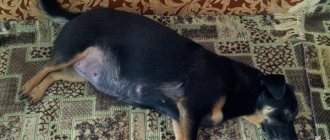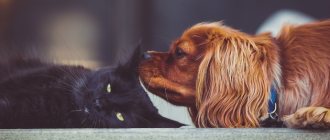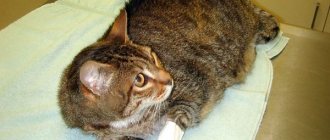Home Animals Cats
Title 1: How to properly wash a cat: how often, at what temperature and why 2 title: Washing a cat at home - choosing products, drawing up a plan, preparing the animal and contraindications. [[[How to properly wash a cat? Is this unpleasant procedure necessary or is it a tribute to fashion? It is necessary to wash, and correctly. You need special shampoos, a little patience and a good mood. There are cases when washing a cat is impossible or undesirable.]]]
It's rare that a cat has a love for water treatments. But nevertheless, pets are often exposed to this action. But bathing is a lot of stress for a cat, so it resists in every possible way. For an inexperienced owner, everything can end in serious scratches. True, cats accustomed to washing from childhood do not react so violently to bathing and are practically not afraid of water.
Cat owners often think about the advisability of water procedures and doubt how correctly they do it and with what frequency. This is a necessary procedure and it is dangerous to ignore it. At the same time, you need to bathe correctly and not when the owner wants. Washing too often can be harmful!
What cosmetics should you choose for your pet? Human gels, shampoos, foams and soaps are not suitable for animals. This is explained by the different acid-base balance of cats and humans. Therefore, you need a special zoo shampoo. By the way, there are products for so-called “dry cleaning”. Special sprays or dry shampoos perfectly clean the coat. However, the procedure should not be abused. Another way to put an animal in order when it is not possible to take a full bath is a “bath” made from bran. True, it is only suitable for short-haired cats; long-haired breeds are not recommended due to the formation of tangles.
Washing kittens deserves special attention. At what age should a baby be introduced to water? How can I help him overcome his natural fear? How much time should you devote to such procedures? There are many questions, but there are answers to them. And we will try to tell you in detail how to wash a kitten and an adult cat. A cat in the bath can behave differently, especially if its first acquaintance with water took place as an adult.
Find out how to bathe a cat if she is afraid of water? At what temperature and in what water should I wash?
Bathing cats is not an easy, but very important procedure in the life of every owner and his pet. Furry sneaks (in their own opinion) do an excellent job of maintaining hygiene, so they react negatively to all attempts to bathe them.
The cat may scream, twist, scratch, and even bite, trying to distract your attention and escape to a dark corner.
Fortunately, not all felines react negatively to this process, and some even enjoy it. Meeting a Don Sphynx or an Abyssinian who cannot tolerate water is a real rarity.
The article will tell you how to properly bathe a cat, even if it is afraid of water.
It is recommended not to feed the cat 3-6 hours before bathing. For bathing, dry or liquid shampoos are used, as well as tar soap (popularly believed that it helps to cope with parasites); in rare cases, the use of human shampoo or shampoo for children is allowed.
- PREPARATION
- BATHING METHODS
- ANSWERS TO FREQUENTLY ASKED QUESTIONS
- USEFUL VIDEO
Useful tips for beginners
An unprepared animal, terrified of water and spontaneously falling into a bathtub filled with water, may begin to struggle, scream, and is also capable of tightly clinging to the owner’s hands or scratching the face. These are very unpleasant and even dangerous injuries.
A cat or cat can harm itself. If they struggle vigorously, they can twist their paws and damage other parts of the body. Therefore, you need to prepare your pet for the bathing process in advance. Felinologists advise training an animal from childhood, especially for breeds with light hair.
Should I bathe my cat?
Cats are afraid of water, so bathing is a serious stress for them. By regularly licking and washing, cats keep their fur clean. However, in some situations it is necessary to bathe a cat:
- If the wool is very dirty;
- The animal was found to have parasites;
- The cat got dirty in toxic substances, such as fuel oil;
- During the molting period, to remove dead hairs.
Washing is additional hygiene for the animal, prevention against parasites, softening and moisturizing the skin, removing lost hair, and simply maintaining the aesthetic appearance of your cat. Therefore, every owner needs to know how to bathe a cat correctly.
How often to bathe a cat
It depends on his lifestyle. On average, a cat requires 5-6 baths per year.
Regular bathing is inevitable for show animals, as their fur is evaluated very carefully. Hairless cats need to be washed frequently because they sweat through their skin. Long-haired dogs are bathed so that less hair falls out.
Kittens should be bathed no earlier than three months of age. Water procedures for small kittens can lead to hypothermia and the baby catching a cold.
Preparation
- Buy a special shampoo that meets the needs of your pet's body. If the animal is allergic, choose products with antihistamine action; if it is infected with worms, fleas and other parasites, pay attention to the variety of medicinal shampoos. Don't forget about the characteristics of the breed! Long-haired cats are better suited to shampoos with conditioner, which make combing easier and prevent the formation of tangles; sphinxes - with an antibacterial effect. Bathing cats with human shampoo should only be done as a last resort.
- Don't make unnecessary movements. Cats are very smart creatures. Noticing that you are rushing around the house, preparing towels, taking shampoo out of the cabinet and making other extremely nervous movements that are unusual for you, the animal will definitely sense something is wrong and will hasten to hide in a safe place. It can hide under the sofa, behind the closet, and in a huge number of hard-to-reach places that you didn’t even know were there. Instead of fuss, allow yourself to prepare the equipment necessary for swimming in advance, two to four hours in advance. The cat, even sensing that you are planning something bad, will most likely forget about it within an hour.
- Talk. Scientists have proven that animals endure stressful situations much easier if they hear the owner’s voice and feel his support. Your tone should be affectionate and soft, the pet should understand that you are aware of how hard it is for him and sympathize with him.
- Prepare a treat. For some cats, this helps distract them from unpleasant sensations. If the animal does not bite or scratch you during bathing, but only meows pitifully, complaining, then the tasty treat will work as an excellent method of distracting attention.
Now that you have prepared both mentally and physically, let’s move on to the main part of the bath procedures.
Bathing methods
1. Traditional.
You should bathe your cat with an assistant, especially if you are doing this for the first time or the animal is too wayward.
After filling the bathtub with warm water to 10 - 12 centimeters, place a terry towel on the bottom. Sitting on such a bedding, the cat will feel more comfortable. Having carefully secured the cat under the front paws so that it does not escape, we carefully wet the fur with our palms.
Care should be taken to ensure that water does not get into your pet’s eyes, ears, or mouth. Pour the pre-prepared specialized shampoo for cats into the palm of your hand and lather it, then massage it onto the fur.
Then rinse the fur and wrap the animal in a towel or soft fabric sheet prepared in advance. Some animals cannot be contained, so it is quite easy to get your pet wet, collecting excess moisture. After bathing, it is permissible to dry the animal with a hairdryer, but only if it does not object.
Be careful! Do not set the temperature in the hair dryer to maximum! The air should be just a little warm, but not hot.
2. Modern. For animals, as for people, dry and spray shampoos have long been invented. They are sprayed onto the fur, after which the cat should be held for a while so that the particles of the product have time to absorb excess sebum, then the fur is thoroughly combed out.
The safety of this method is controversial, but in cases where the cat is terrified of water, such means should be used. This will keep the animal clean without injuring it.
Tar soap for fleas in cats: how to use?
Tar soap based on birch tar contains natural substances that have disinfestant properties. It is believed that it can remove fleas from cats.
Tar soap is used against fleas on cats.
IMPORTANT: Yes, tar soap against fleas helps, but the procedure will have to be carried out several times, perhaps a lot. The soap solution washes out or kills fleas, but not their eggs. Frequent bathing is harmful for cats; it is preferable to use modern means that get rid of fleas in 1-2 applications.
If you still decide to remove fleas from a cat with tar soap, it is done like this:
- Prepare a soap solution. 0.25 soap is grated and completely dissolved in 200 ml of warm water.
- Moisten the cat's fur with regular warm water.
- Treat the wool with a solution of tar soap so that it gets on the skin. Thoroughly wash the folds of the paws, under the tail, neck and withers.
- Keep the animal in a soap solution for 5-10 minutes.
- Carefully wash off the tar soap from the cat's fur.
- Repeat the procedure every 2 weeks as necessary (it is in 2 weeks that flea eggs hatch).
IMPORTANT: Even after thorough rinsing, a specific smell of tar soap remains on the animal’s fur, which can cause discomfort to the animal. If a cat does not respond well to the procedure for removing fleas with tar soap, it is better not to repeat it and choose another product.
“Tactics” for training a cat to use the bathroom
Before teaching a cat not to be afraid of water, you need to overcome all the accompanying discomfort. Carry the animal into the bathroom in your arms; if the cat does not strain, try turning on the water for a short time. Calm your cat down, let him know that he is protected, but be prepared, the sound of running water can throw the cat into panic.
Try putting the animal in a dry bath; most likely, the pet will immediately run away, but this is only the first stage. Agree with your pet, do not try to wet the fur or force the cat not to be afraid, forcing events will only add to the hassle. Gradually, patiently, agreeing to the animal’s conditions and that’s the only way!
Important! Bathroom lighting is a separate issue. It has been established that animals experience fear if there is not enough light in the room. Change the light bulbs to brighter ones or install an additional light above the bathroom while you study.
Naturally, it is easier to accustom a kitten to water; the little one who unconditionally trusts you will accept or at least tolerate water procedures after 3-4 “training swims”. It is difficult, sometimes impossible, to train an adult cat. If your pet doesn't go outside, it's easier to give him a quick bath than to torment him for months of training.
What to do after
After the foam is completely washed off, the cat is thoroughly dried with a well-absorbing towel, wrapped and thus dried. Calm pets, especially long-haired ones like the Ragdoll or Ragamuffin, can be dried with a hairdryer. It is important to set the warm air (so as not to burn the cat with a hot blow and cause discomfort to it). If she protests extremely, you can do without a hairdryer.
Be sure to dry your washed cat with a towel.
Be sure to make sure that the room where the pet is located is warm enough. After bathing, the cat should not be allowed to be in a draft or sit on cold surfaces. This simple rule will protect her from colds.
It is advisable to give her a full grooming session, brush her teeth, wipe her ears, possibly wash her eyes, trim her claws after bathing (however, for aggressive, restless cats, it is wiser to trim their claws before water procedures).
If your pet is not yet accustomed to washing and feels insecure, you should not strain him with unnecessary manipulations at one time. It is better to postpone the remaining care procedures until next time, doing them gradually separately.
Answers to frequently asked questions
How to wash a cat if she is afraid of water?
Do not confuse acceptable fear, bordering on discontent, and panic horror. If an animal reacts to bathing very tolerantly, simply trying to run away during the process or meowing quietly, this does not mean that it does not need to be bathed. Most cats perceive bathing as an act of violence, but I have never met a single owner who, because of this, would leave his “Murka” dirty and unkempt.
If the animal’s fear of the water element is enormous, it thrashes, scratches, hisses, and pure horror splashes in its eyes - the second method of bathing is especially for you.
At what temperature should you wash your cat?
The temperature at which a cat should be bathed should not be too hot (over forty-five degrees) or too cold (below thirty-five). The normal body temperature of cats ranges from thirty-eight to thirty-nine. Knowing this indicator, you can adjust the water so as not to freeze the animal.
The optimal temperature for bathing cats is considered to be forty to forty-two degrees Celsius.
What water should I wash my cat in?
Yes, you can bathe cats in any tap water! Indicators of impurities, chlorine and iron content in this case do not play as important a role as we are used to.
The only thing is that you should refuse to wash if your water was turned off and now, when you turned it on, brown, red, rusty, black slurry comes out of the tap.
If the water is clear and does not have a repulsive odor, you can safely bathe your pet in it.
Why does a cat panic when he sees a full bath?
Does the cat prefer to avoid the bathroom, avoid the owner who has come out of the shower, and does not approach the country pond? Why?
- Felinologists say: There is always a warm air layer between the pet’s skin and the ends of the fur.
- Thanks to her, the cat feels cozy, comfortable and protected from the cold. If the animal gets wet, the comfort will disappear and the cat will begin to freeze.
- The pet does not like this feeling very much. She begins to panic, break free, rush about. It is possible to accustom a cat to water.
It is important to be patient and apply existing knowledge. In the video of washing cats you can see the process of bathing a pet that is almost accustomed to water. However, to achieve such a result, you need to spend some time.
Rules for swimming
Many people believe that cats are terrified of bathing. The aversion to water is based on the animal's subconscious instincts for safety reasons. If you are properly accustomed to bathing while still a kitten, then there will be no problems with this. It should also be noted that bathing a sick animal is prohibited. This can affect your pet's immune system, resulting in serious illness.
© shutterstock
Before you start washing, you need to take care of your cat's ears and eyes. When applying shampoo, soap suds can get on the mucous membrane of the eyes and ears. Therefore, you need to use eye drops for your eyes to prevent irritation and pain. Use cotton swabs to protect your ears.
Ways to bathe pets
- As a container, you can use a sink or a small basin filled with 10-12 cm of water. The suitable water temperature for washing is 39°C. To prevent the paws from sliding on the enamel surface of the sink, place a towel on the bottom;
- You need to pour a small amount of shampoo or gel into a bag that is capable of allowing water to pass through and place the pet’s body, leaving the head outside. The cat should be held by the scruff of the neck with a soft but firm grip. When lowering the cat halfway into a container of warm water, you need to make circular movements with your hand, saying kind, gentle words. The animal must feel the safety of the actions being carried out.
When bathing, you can use a non-rough sponge to wet all the fur except the head. It is necessary to rub the shampoo in with massaging movements so that a layer of foam is formed. Some breeds find this procedure enjoyable and may even purr. If there are fleas, you need to wash your hair, but very carefully. To do this, you need to soap the surface of your head with a well-wrung out sponge so that the foam does not flow onto your eyes, ears and mouth.
You need to wash off the foam with water, which should have a temperature of 39-40°C. The stream of water should be directed from head to tail in the direction of the fur. You should thoroughly rinse the area of your armpits, belly and under the tail. The second step is to apply the balm, which also needs to be rinsed. After the procedure, the cat should be wrapped in a warm terry towel. When drying, it is not recommended to rub vigorously, otherwise the long hair will become tangled. While drying, the pet should be kept warm, after which the fur should be combed well.
© shutterstock
Features depending on breed
The meaning of bathing and the procedure for carrying out this procedure are similar for all cats, but have distinctive nuances for some breeds. It should be understood that cats with long, short, thick, curly hair, as well as representatives of hairless breeds, require an individual approach.
Longhair
Breeds such as Persian, Maine Coon, Turkish Van and others. Before bathing, you need to thoroughly comb your pet with a brush, check if the fur is matted, and remove all tangles. When washing, it is important to rinse your hair thoroughly, wash it carefully so as not to pull the strands, which can cause pain to your pet, and wash off the foam well.
You should choose a shampoo designed for long-haired cats, taking into account the type of hair (fluffy, smooth, straight, etc.). If the coat is prone to matting, it is useful to use shampoos for detangling, as well as additional conditioners, masks or lotions, so that it is convenient to comb your pet in the future. Long-haired pets should be bathed 1.5 - 2 times more often than short-haired ones, however, it is also not necessary to subject your pet to water procedures.
With plush fur
These are breeds with a very thick, short hair - Scottish, Toyger, British, Ocicat, Chartreuse and others. Shampoo for short-haired cats, as well as one specially designed for representatives of these breeds, is well suited for bathing such pets. The difficulty is that such thick wool is inconvenient to completely wet and then remove the remnants of the cosmetic product. Therefore, you need to carefully moisturize the hair before applying shampoo, and when rinsing, make sure that no foam remains on the cat.
Shorthair
These are primarily representatives of such breeds as: American and European Shorthair, Oriental, Havana, Belgian and others. There are no special features in bathing, the main thing is to choose the right shampoo appropriate for the age and breed, and also adhere to the general rules of bathing.
Curly
Some of these breeds are LaPerm, Cornish Rex, Devon Rex, Selkirk Rex and others. These pets are bathed as needed, keeping an eye on the condition of their hair. Particular attention should be paid to long, curly hair, as improper care can cause the curls to become somewhat straightened and become less attractive. You should not wash representatives of such breeds unless necessary. An important point is care after bathing. Such pets are dried well, preserving the curls of the hair, and gentle tools are used for combing.
Bald
Now there are already many such breeds - Don Sphynx, Canadian Sphynx, Peterbald (Petersburg Sphynx), Bambino, Dwelf, Minskin, Ukrainian Levkoy, Elf, Kohana and others. Bathing such pets is a separate issue, since they either have no hair at all, or the hair is too short and sparsely growing (velor cats). If such a cat gets dirty, it can be bathed in warm water using a special shampoo or soap for hairless cats, however, experts advise minimizing such procedures and replacing them with regular wiping of the pet with a soft cloth. There is no need to wet such cats unnecessarily - they freeze easily and can catch a cold.
Bobtails
Apparently, almost all cats from the Bobtail group inherited a love of swimming from their wild ancestors. And not necessarily in a warm bath. They enjoy splashing around in natural bodies of water while out for a walk. These are American, Japanese, Karelian and Kuril Bobtail, and Mekong, and Pixie Bob.
Breed influence
Cats with fur feel good when bathing if the water is heated to a comfortable temperature equal to body temperature.
Sphinxes are a completely different matter. This breed is characterized by the absence of hair, so the animals quickly freeze and become hypothermic.
They have different requirements for water: it is heated to +39…+40°C.
It is necessary to monitor the air temperature: if it is cold, bath procedures will cause hypothermia. The risk of developing colds increases.
The importance of compliance with these standards
One of the main reasons why cats refuse to bathe is an anxious situation. Everything scares animals:
- noise;
- lack of support;
- moisture;
- getting drops on the head, eyes, ears;
- unfamiliar sensations.
Often, a kitten jumps out of a basin or bathtub in fright because it is very cold or hot. Because of the first unsuccessful bathing experience, it is often impossible to persuade the animal to repeat water procedures.
Possible consequences of non-compliance with temperature conditions
The danger of hypothermia is that it increases the risk of developing colds. Against this background, hypothermia often occurs. Most often, owners of small kittens face this problem.
An animal at an early age is not able to regulate its own body temperature, quickly freezes, and because of this, the functioning of the digestive system is disrupted.
Accordingly, the body does not absorb nutrients. The pet cannot keep warm. The risk of death in such a situation is high .
You need to seek help from a veterinary clinic. The skin of pets is very sensitive, so there is a high probability of getting a burn. The owner thinks the water is warm, but for the animal it turns out to be hot. Overheating develops and burns appear.
Another problem that arises when these standards are not followed is dry skin. Such changes are observed when bathing in cold or hot liquid, or when washing the cat frequently.
What makes cats afraid of water?
Driven by curiosity, scientists have put forward several theories to explain the causes of irrational phobia in most members of the cat family. In the course of their research, they came to the conclusion that it is not fear that motivates cats to avoid contact with water, but the instinct of self-preservation.
Cats are excellent swimmers, capable of covering long distances. A 1-month-old kitten submerged in water, for example, can swim without assistance.
Whiskered pets not only hunt well, but also swim well
Table 1. Main factors provoking fear of water procedures
| Cause | Explanation |
| Risk of hypothermia | There is an air cushion between the top layer of hair and the dermis. It absorbs heat emanating from the body and warms the pet. When wool gets wet, it loses its insulating properties. |
| Possibility of overheating | The air gap protects from overheating by preventing exposure to sunlight. For dogs, for example, to survive the heat, it is enough to breathe with their tongue hanging out. Cats that do not have this ability can only rely on a pillow. |
| Increased smell | When the fur gets wet, it gives off a strong odor and makes the animals vulnerable to large predators. In addition, such a clear cat scent complicates the hunt. The victim senses the approach of the enemy and manages to escape in a timely manner. |
| Growth of pathogenic bacteria | Wet hair absorbs more dust than dry hair. When washing, dirt enters the cat's stomach and provokes the proliferation of harmful microbes. |
Zoologists believe that cats are aware of the negative consequences of bathing and do not want to put themselves at risk. They remember at the genetic level that wet wool contributes to heat loss.
In the large family of cats there are lovers of water treatments. These include servals, tigers, Sumatran cats and jaguarundis.
Unlike cats, dogs can shake off water.
While observing the behavior of cats and dogs, researchers made another interesting discovery. Representatives of canines are active hunters. In pursuit of prey, they cover long distances. If they need to dry off, they either shake off drops of water or get rid of moisture while jogging. Fluffy pets obtain food in a less energy-consuming way. They spend most of their time in ambush, patiently waiting for prey. And they don’t know how to shake themselves off.
Why don't cats like water?
No, this is not a whim or character flaws, but an instinctive fear. In nature, a wild cat will go into the water based solely on survival instincts. There are exceptions, for example, tigers are swimmers and fishermen who can easily endure water procedures due to the water-repellent structure of their fur. It just so happens that more than 80% of domestic cats hate bathing, while the remaining 20% tolerate it. From the point of view of cat psychology, purrs do not like water because their fur quickly gets wet, and water, especially with shampoo, dries out delicate skin.
If you hope to “twist” your pet and bathe it “somehow”, give up the illusion; without washing the fur, you are risking the health of your ward. In addition, true fear provokes animals to desperate actions, fighting charms and torn clothes are provided to you, and after that, wet slippers and torn wallpaper as moral compensation for the “abuse”.
Bathing rules
Kids quickly get used to the bath day. Therefore, it is advisable to introduce it to water immediately after changing teeth. In addition, it is much easier to cope with a kitten’s hysteria than to withstand the panic of an adult cat.
Kittens are more tolerant of wet grooming than adults
First of all, you need to decide on a place for bathing, choosing between a bathtub and a sink. For small pets, the second option is suitable. Many owners choose a cup-shaped device based on personal comfort. When bathing a cat, there is no need to remain in an inclined position for a long time. For long-haired breeds, it is more convenient to use the bath.
Preparing for washing is no less important than bathing itself.
Required accessories
Before bringing your pet into the bathroom, you should prepare the tools used during bathing. You will need the following accessories:
- Shampoo. You should purchase detergent for cats. Products designed for people are not suitable for cats. For basic care, a degreasing shampoo is suitable. If your pet has matted long hair, texturizers are recommended to make combing easier. Cleansing pastes are good for problem areas.
- Air conditioner. You need to choose a rinse based on your pet's coat type. The product should not irritate the eyes.
- A shower equipped with a special button, when pressed, water flows. This device significantly speeds up the washing process.
- Bucket capacity up to 2 liters and 2 buckets. These items are necessary if your pet is afraid of the stream flowing from a faucet or shower.
- Latch. The accessory is made in the form of a collar with a suction cup, which is attached to the bathtub. The invention prevents the cat from running away from its owner while washing.
- Massage mitten. Helps to apply shampoo evenly and removes dirt well.
- 2 towels. To prevent the animal from catching a cold, it must be thoroughly dried. The first is to remove the main moisture, and the second is to dry it. Timely drying quickly restores the pet's thermoregulation.
Having prepared the listed items, you can start swimming.
Step-by-step instruction
The bathing algorithm is quite simple. It is suitable for both beginners and advanced swimmers.
Step 1. Preparing the animal
Brush the cat and trim its claws. The last procedure will protect the owner from scratches. If there are tangles on your pet's body, they must be removed.
How to trim a cat's claws
Step 2: Cleaning the bathroom
Remove all objects that the cat could snag or turn over during the washing process.
Step 3: Wear protective clothing
Wear things that don't have fur on them. It is also useful to come up with a uniform that the animal cannot get its claws caught on.
Step 4. Help from an assistant
If the cat belongs to large breeds, an assistant is invited. Bathing together is much easier. Distribution of responsibilities: one person fixes, the second washes.
Step 5. Preparing the water
If the cat is wary of the stream flowing from the tap, use a shower. Make the pressure moderate and the water warm. Pre-fill the sink or buckets placed in the bathroom with water. Dilute a small amount of concentrated shampoo in a ladle. Do not apply detergent to dry hair.
Some pets are repelled by the pulsating flow of water from the faucet.
Step 6. Fixing the pet
If you plan to immerse the cat in water, keep the forelimbs and hind limbs crossed. Smoothly place the animal in the sink and release the hind legs.
Step 7. Bathing the cat
The procedure takes about 15 minutes. Taking a small amount of water into your palm, wet the wool. Then apply pre-dissolved shampoo. Splashes should not get into eyes and ears. To protect your ears, you can cover them with cotton swabs. Wash your face at the final stage without using soap. The cat takes excellent care of this area on his own. Direct the water onto the back in the direction of the hairline. Use a massage mitten to distribute the water flow over other areas. Rinse the detergent from top to bottom. Use the rinse aid in the same way. To prevent shampoo or conditioner from getting into your pet's body while washing, the fur is washed well. Residues may cause itching and burning.
The animal should be washed with leisurely and gentle movements.
Step 8. Drying the wool
Cover the animal with an absorbent towel and allow the moisture to be absorbed into the fabric. Blot the wool, but do not rub it. If your pet responds adequately to the hair dryer, you can dry the hair with it without using the device at full power.
When is it necessary to bathe a cat?
Frequent bathing is contraindicated for pets. While washing, cats clean their fur and epidermis of dust. The effect of licking your hair on your own is comparable to bathing and combing at the same time. This is achieved thanks to the special structure of the cat's tongue.
If your cat gets very dirty during a walk, you should help her clean herself of dirt.
On the tongue of cats there are papillae shaped like spines. They help your pet retain food and water on its surface and clean its hair.
A cat's tongue is equipped with special fibers that help clean the fur.
However, in emergency cases, animals must be helped. In addition, veterinarians recommend providing assistance to pets in the following situations:
- Seasonal shedding. Water treatments help remove dead hairs in a timely manner, thereby preventing their accumulation in the stomach.
- Presence of parasites. Regular washing with anthelmintic shampoos helps remove roundworm eggs and other worms. This is especially true for animals walking outside.
- Age factor. Over time, some pets either cannot cope with personal hygiene on their own or become lazy.
It should be remembered that frequent use of detergents leads to degreasing of the epidermis, which causes the formation of dandruff.
How to get rid of a cat's fear of water
The attitude towards water procedures is formed during the first wash. In most cases, a phobia develops due to the fault of an impatient owner. Cats are considered willful and independent animals that do not tolerate violence. Therefore, using force will only make the problem worse.
If your pet is terribly afraid of water, you need to teach it to bathing gradually.
Bathing should begin by immersing the cat in a container filled 5 cm with warm water. To arouse your pet's interest, place his favorite toy in the basin. It is not recommended to force a cat into water. It is advisable that at this moment he is well-fed and well-rested.
By repeating this procedure several times, you can complicate the task. To do this, you need to place a board across the bathtub with toys. The height of the structure should be comfortable for the animal trying to get the trinkets. After jumping into the water, the cat may get scared and run away. However, once she realizes that she is not being forced to dive, she will try to pull out her favorite toy again. When your pet gets used to the water, you can start bathing.
A basin with toys will encourage curious animals to wet hygiene
How often can you bathe a cat?
The fur of furry pets is covered with natural fatty lubricant, which performs protective and thermoregulatory functions. With regular bathing, it is washed out and makes cats susceptible to infectious and colds. In addition, drying of the skin occurs, which negatively affects the quality of the coat. Therefore, veterinarians do not recommend abusing water procedures.
Frequency of bathing:
- walking - once every 2 months;
- home lifestyle - once every 4 months.
You should not completely immerse the cat, just wet his paws for the first time.
Hairless animals, such as sphinxes, are bathed once every 4 weeks. In case of severe contamination of the fur or the presence of fleas, unscheduled trips to the bathroom are possible. Swimming is prohibited for 2 weeks after vaccination and after surgery until the sutures are completely healed.
Most often, sphinxes like to bathe and even play in the bathtub
It is not advisable to bathe a cat during pregnancy. The application of detergents does not pose a danger to the life of the expectant mother. However, the procedure can provoke a state of panic, which will negatively affect the health of kittens. In addition, trying to jump out of the bathtub may cause injury to the animal.
Can I use regular shampoo?
The veterinary industry is developing rapidly and, in addition to industrial feed and medicine, much attention is paid to animal care cosmetics. In addition to liquid products, dry shampoos and sprays are available on store shelves. The former well neutralize the consequences of the active work of the sebaceous glands. The latter are suitable for animals that cannot tolerate contact with water.
Cats should be washed exclusively with specialized shampoos.
You cannot wash an animal with human shampoo, even one designed for children. Detergents are especially dangerous for kittens. The chemical elements they contain remain on the skin even after thorough washing. Penetrating into the stomach while washing, they lead to eating disorders.
It is not advisable to use soap or shampoo intended for humans on the fur of furry pets. This taboo is due to various indicators of acid-base balance. The PH level of human skin ranges from 3.5 to 5.5, while that of a cat ranges from 3 to 6 units.
The wool must be treated with a special shampoo for cats.
How to behave while swimming
To make this process comfortable for both the owner and the pet, you should adhere to a few simple rules of behavior:
- Make bathing part of the training process. From an early age, accustom your animal to washing, motivating him with his favorite treat.
- Be gentle, kind and persistent. Talk to your pet and under no circumstances use raised voices.
- Distract your cat with toys. Since this event is stressful for most felines, it is advisable to reduce the tense psychological temperature with the help of his favorite items.
- Bathe your cat together. If your four-legged friend resists strongly, you should invite an assistant. During bathing, one person will hold him by the paws and withers, and the second will do the washing.
By being patient and respecting the emotional state of the cat, you can achieve success and instill in the animal a love of water treatments.
How to bathe a cat for the first time?
So, we found out that your cat should first become acquainted with water and shampoo at a young age. It should be remembered that a kitten has a vulnerable child’s psyche. The owner’s task is not to instill in the baby a persistent aversion to water and the entire procedure as a whole. To do this, you must follow some rules. The baby’s attitude towards this procedure in the future depends on the very first bath.
A kitten should be accustomed to water from three months. Usually, before this age, his mother washes him out. However, there are exceptions to every rule. If a kitten is very dirty at the age of one month, then it can and should be bathed. You should not carry out the first procedure in the bathroom. A basin is more suitable for this, as it doesn’t look as intimidating to a baby as a huge white bathtub, and it will also be easier to keep him in the water.
You need to pour a little water so that it just reaches the kitten’s tummy. While bathing, talk to your baby in a quiet voice and call him by name. Do not wet the kitten's head from the shower; clean the fur on it with a sponge. Use shampoo for kittens, choosing it based on your pet's coat type. If you can’t purchase it, use any children’s one.
How to wash your cat's eyes and ears
So, even the most capricious cat was washed, but during bathing we went around the eyes and ears, and they should also be clean.
The cat's eyes are wiped with a cotton swab dipped in clean boiled water or a weak solution of tea or chamomile. Movements should be light, no need to press or rub your eyes.
It's time for ears. There is no need to clean them unless they become dirty. However, after washing the cat, water could get into the ears. You need to wipe the outer part of the ear with a cotton swab, on which it is better to twist an additional layer of cotton wool. Use a clean stick or dip it in a drop of Vaseline oil. Water and other liquids cannot be used. As a rule, cats love to clean their ears and are happy to present them to their owner. Healthy cat ears should be pink, clean, and free of unpleasant odor.
Washing and bathing cats and kittens
Home :: Keeping and caring for cats :: Washing and bathing cats and kittens
Washing cats and kittens is a means of grooming; many people believe that cats wash themselves (lick themselves) and therefore do not need this procedure. But there are times when a cat gets so dirty that it cannot be avoided. However, remember that you should not wash a sick pet because it is susceptible to infections.
There is an opinion that cats are afraid of water, so many owners have doubts about washing cats. But if kittens are washed from an early age, bathing will not be difficult.
Before washing your cat, take care of its eyes and ears. To prevent your eyes from becoming irritated by shampoo or soap suds accidentally getting into them, you need to put eye drops in them before the procedure. Plug your ears with cotton to prevent water from getting into them. Bathing cats and kittens can be done in several ways.
Fill the sink with warm water (water temperature for bathing cats should be about 39 ºС) to 7-10 cm. To prevent your pet from slipping, place a terry towel on the bottom of the sink. You can take a regular small basin.
Bathing cats can be done in another way. Take a strong but water-permeable bag, add some shampoo to it and place the cat in it, leaving only the head outside. Then submerge halfway in warm water. While washing the cat, hold the cat by the scruff of the neck, grasp the skin gently but firmly, do not let go, while saying kind words to your pet.
When bathing cats, after you have placed the animal in the water, gently wet the entire fur except the head with a sponge and gently massage the shampoo into the fur until a lather forms. Some cats really enjoy this procedure and even purr.
If a cat has fleas, she will have to wash her hair too. In this case, it is convenient to use a sponge, wet it, gently lather the surface of the head, avoid getting the foam into your eyes, ears, nose or mouth.
After washing your cat with shampoo, rinse the fur with warm water. Direct the flow of water from the head - the way the fur lies. Pay special attention to the abdominal area, areas under the tail and under the arms. Next, apply the balm, rinse it off, remove the cat from the sink or basin and wrap it in a large, warm towel.
Dry the cat carefully; if the cat has long hair, do not touch the long fur so that it does not get tangled. After bathing, it is better if the cat is kept warm until the fur is completely dry. After the procedure, you can comb the cat.
If the cat is young, weak or old, then dry washing can be used. This procedure is effective for animals whose fur is greasy or matted. Sprinkle with talcum powder, wipe it off and comb the coat with a comb. In this way, the kittens can be washed, and then proceed to bathing them in water in order to gradually accustom the pet to this procedure
When brushing out the powder, hold the cat's head so that the powder does not get into her eyes and nose. Nowadays there are a lot of special lotions for cats. They are especially good for hairless cats. A cloth is moistened with lotion and the animal is wiped with it.
About water procedures
– There are a lot of disagreements and disputes around whether cats need to be bathed. Many owners believe that it is not necessary to wash animals, because mustachioed animals are very clean and take excellent care of themselves. This is partly true,” says veterinarian Oksana Levchenko . – You should bathe cats only if they are dirty and cannot clean themselves. But you shouldn’t do this more often than once a month. This risks washing away their protective lipid layer and causing the animal to experience itching and flaking.
How to prepare for washing?
Before bathing, feed your pet and play with it. You need to make sure that the purr splashes out as much energy as possible before water procedures and does not make you run around in the bathroom.
Prepare shampoo and a towel in advance so that you don’t leave your pet alone in the bathroom if you decide to run to another room for something. Also, remove all objects that the cat could touch or break if it wants to escape from you.
How to bathe correctly? Do this in the bathtub, sink or basin. Place a rubber mat on the bottom so that your pet can cling to it with his claws. The water should be warm, preferably 38 degrees. You need to gain about 7-8 centimeters. Cover the purr's ears with cotton wool to prevent water from getting in. Do not wet the animal's head.
Which shampoo to choose? Use special shampoo for cats. It is sold in pet stores and veterinary pharmacies. The usual shampoo that the owners use will not work, since humans and animals have different skin acidity.
At what age can kittens be bathed? Very young kittens, less than two months old, do not need to be bathed. From the age of three months you can begin to accustom him to water. You shouldn’t immediately drag your pet into the water; start by wiping its paws.
What if the cat is afraid of water? There is a solution - dry bathing. It is enough to wipe hairless cats with special wipes, while short-haired cats can be cleaned with bran.
To do this, you will need from 0.5 to 1 kg of bran, which needs to be heated in the oven. The bran should be warm, but not hot. If you cannot pick them up yourself, under no circumstances wipe your pet with them so as not to burn them.
Pour warm bran into a tray, box or newspaper, place the purring furry in it and begin to wipe it with both hands, then wipe off the remaining residue with a towel. In most cases, the animals like it. Cats love warmth. After this procedure, the coat will become more shiny.
How to teach a kitten to bathe
Bathing a small kitten when it is only a month old is not recommended unless absolutely necessary. If, for example, he gets his paws dirty in the tray, they should be wiped with a wet napkin and wiped dry, but do not wash the baby all over. It is optimal to start accustoming a kitten to water starting at the age of 4 months. This process is quite lengthy and requires patience from the owner, since not every kitten, despite all efforts, is able to get used to bathing. In order for a kitten to stop being afraid, you need to teach it to wash in water in the following sequence:
- the kitten gets acquainted with the bathing basin - it should not cause fear in the animal. First, you need to show the basin to your pet, and then put the baby in it even before the water is poured. Then the kitten is taken out;
- water at a temperature of 38-40 degrees is poured into the basin to a depth of 5-7 cm;
- the kitten is placed in a basin of water, speaking to it in an even, calm voice, while at the same time holding it tightly;
- The pet's head is quickly wetted, making sure that water does not get into the ears and nose. They try to wash it briefly, since the kitten, as a rule, does not like to bathe.
If the kitten is very nervous, then before bathing you should give him a little sedative designed specifically for kittens. Regarding which product to choose and in what dosage to give it, it is worth consulting with a veterinarian.
© shutterstock
It is important to remember that the sooner the bathing is over, the better. You should not force your kitten to endure unnecessary exposure to water.
When not to wash your pet
Sometimes situations arise in which regular washing may be contraindicated for cats. Owners are beginning to wonder how to wash their cat without water and whether it is even possible - fortunately, it is possible.
Contraindications to regular washing include pregnancy (bathing can cause stress in the cat and, as a result, premature birth), the postoperative period, 2-3 weeks after the cat has been vaccinated.
Some illnesses are a contraindication to regular washing; you should consult your veterinarian on this issue. It is better to refuse bath procedures if the cat is constantly itching and has unhealed scabs on its skin.
There are several ways to wash a cat with and without water, without causing stress to the animal. They can be used to clean a dirty pet during pregnancy or illness.
Cat bathing temperature
When bathing kittens and adult cats, do not use hot or too cold water. The pet should not be scared, burned or frozen, especially since some breeds of cats are heat-loving and a cold shower will be dangerous to their health. The optimal bathing temperature for a cat is 39o C.
To wash cats, it is recommended to use a special domestic and imported pet shampoo. If you don't have shampoo, you can use baby soap.
Regular human toilet soap, powder and shampoo are not suitable for caring for cat fur. They are harmful not only for bathing small kittens, but also for adult cats, as they have a negative effect on the fur and epidermis and are poorly washed off with water.
You should not wash cats often, because fat is removed and thus the natural protection of the skin and coat is reduced; it is usually recommended to bathe cats once every 2 months.
The animal should not be placed in water after eating; at least four hours must pass. By following these recommendations, you and your pet will enjoy washing.
What water should I bathe my cat in?
Drying the animal after washing
At the end of the procedure, be sure to dry the animal. Drain the water from the bath and cover the cat with the first towel, lightly blot the fur with it. Do not rub to dry it as quickly as possible - this will tangle the hairs.
Take a clean, large towel and wrap your cat in it, holding him close to you to show you care - you can whisper something soothing in his ear. She may start shaking violently, but after a couple of minutes it will go away and she will calm down.
Try drying the animal with a hairdryer. Have a helper play it in another room so your cat gets used to the sound. Holding it securely in your hands, gradually approach the hair dryer, open its muzzle and direct a warm stream of air at it. If your pet reacts more or less calmly, continue to remove the towel in parts and dry it with a hairdryer. In the future, the cat will understand that the heat source comes from this noisy unit, and will treat it more calmly.
If the cat is frightened by the hair dryer and tries to break free and run away, leave this idea. Release the cat so that it can dry naturally. Make sure that there are no drafts in the room, otherwise your pet may catch a cold - after all, she has become more vulnerable without her air cushion under her fur. Most often, kittens and older cats are susceptible to colds because they do not regulate their body temperature well.
If there are no radiators in the house, turn on the heater for your pet and let her dry near it. After water treatments, the cat will lick its coat for a long time, and there is no need to interfere with it.
Wash water temperature
To ensure proper care of the fur, you need to know what temperature is suitable for your cat when bathing. It is determined depending on the characteristics of the breed.
Many animals are thermophilic, so cold water can be dangerous to a cat’s health and immunity. Hot water can burn the skin, frightening your pet and leaving a burn. For simple breeds, an average temperature of 38-39°C is suitable; if the cat feels chills or tries to sneak away, you can increase the temperature to 40 degrees.
When bathing, you need to use special products that are designed specifically for animals. Some gels and shampoos for humans may not be suitable for cats, which can cause irritation, itching and redness of the skin. They also dry out the fur and take longer to wash off with water.
What problems can be identified?
When bathing, it is wise to inspect your pet. When raking the fur, you need to carefully examine the skin, look at the folds between the fingers, ears and other hard-to-reach places. Often during bathing many problems can be identified:
- fleas, ticks, other external parasites;
- wounds (scratches, ulcers, abscesses, etc.);
- rash of various etiologies (origins);
- various neoplasms on the skin (papillomas, lipomas, other tumors);
- bald patches if the pet has long hair and such areas are covered with hair.
Some problems can be solved on your own, for example, removing fleas or treating minor skin lesions. In other situations, you need to take the cat to an appointment at a veterinary clinic, where you can describe the situation in detail and receive qualified help.
What toothpaste and brush are required for cats, their price and how often should you brush your teeth?











